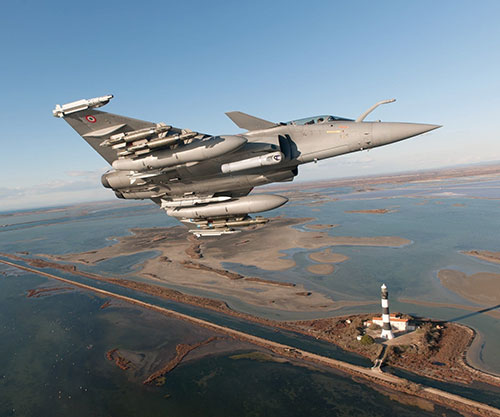The French Ministry of the armed forces, published on March 17th the following press release:
Admiral Pierre Vandier - Chief of Staff of the French Navy, and Air Force General Philippe Lavigne - Chief of Staff of the French Air and Space Force, jointly approved the entry into operational service of the Rafale F3-R fighter jet.
• The upgrading of the French combat aircraft capacities ranks high on the list of priorities of the French military expenditure plan (LPM) which provides for a 2.7 billion euro investment in the development of the new versions of the Rafale over the 2019-2025 period.
• The French Navy and the French Air and Space Force are now authorised to make operational use of all the capacities that are developed around the F3-R standard, which is already installed in half the French fleet and will eventually be installed on all Rafale aircraft in service. Both forces now have a world-class multirole fighter aircraft at their disposal capable of operating in the most contested environments.
• The decision also applies to the Rafale aircraft of the GAE (carrier air wing) operated from aircraft carrier Charles-de-Gaulle, or those of the French Air and Space Force that are deployed from the forward air base in Jordan within the framework of operation Chammal.
The entry into operational service is the culmination of a process, which within both armed forces consisted of determining and disseminating the applicable operating tactics defined for the new capacities of the multirole aircraft, as made possible by the F3-R standard, and particularly those offered by the long-range air-to-air Meteor missile and the TALIOS land-based target designator.
The combination of the AESA RBE2 radar and the long-range Meteor missile gives the Rafale the air superiority it needs for beyond visual range engagements in all weather, as required for handling a wide variety of targets.
The new version of the Rafale will continue to carry the enhanced medium-range, air-to-ground missile (ASMPA) as part of airborne nuclear deterrence missions.
The F3-R Rafale is now capable of using the TALIOS high-resolution laser designation pod, which can generate images in both the visible and infrared ranges, and will benefit from largely improved capacities that will enable it to perform intelligence and target acquisition, and tracking and designation missions. In particular, the Rafale will feature new and more efficient fixed or moving target tracking capacities, as well as an automatic moving target detection capacity and a new human-machine interface that will make it easier to use.
In the new standard, the Rafale F3-R will also offer an enhanced ground attack capacity. It will now be possible to control the munition flight time, the laser illumination and the in-flight weapon settings, including for the terminal laser guidance AASM (modular air-to-ground weapon system).
The Rafale F3-R will also feature an automatic ground collision avoidance system (AGCAS) that will make it safer. The AGCAS is an ultimate protection function designed to prevent any risks of ground collision.
From 2022 onwards, new capacities will be added to the Rafale, with the F4 standard. The aircraft will include innovative connectivity solutions offering enhanced networked combat operation capabilities. Enhanced radar sensors and forward optronics will also be added, as well as a helmet-mounted display and new integrated weapons, such as the air-to-air MICA NG missile and the modular 1000-kg air-to-ground weapon.
Capacities associated with the Rafale F3-R standard include:
- Sustained air superiority capacity, with: The Meteor missile and a robust radar (also robust in dense EW situations) and an enhanced Spectra EW system reinforced alert capacity against enemy threats
- Enhanced resilience against GPS jamming
- Faster decision loop and sustained interoperability
- Higher ground target identification and designation capacity, with the integration of the new laser designation pod (TALIOS)
- Sustained in-flight refuelling capacity, with the integration of a new-generation pod (NARANG)
- Integration of the GBU16, laser-guided 500 kg bomb
- Enhanced flight safety, with the integration of an automatic ground collision system
- Enhanced support system, with an accelerated and more accurate fault diagnosis capacity
Eric Béranger, CEO of MBDA, said: “I’m delighted to see that Meteor, which brings together the best technologies from six European nations, has reached a key milestone. It is now fully operational on Rafale F3-R. We are proud of the sophisticated air-to-air engagement capability that Meteor brings to Rafale. Developing European common military capabilities that are truly revolutionary: this is our mission.”




















